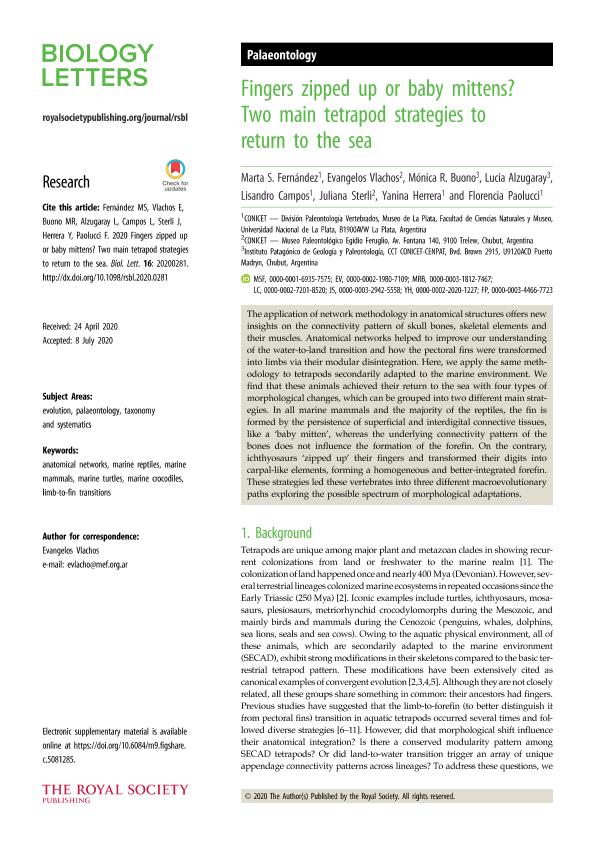Artículo
Fingers zipped up or baby mittens? Two main tetrapod strategies to return to the sea
Fernández, Marta Susana ; Vlachos, Evangelos
; Vlachos, Evangelos ; Buono, Mónica Romina
; Buono, Mónica Romina ; Alzugaray, Lucia; Campos, Lisandro
; Alzugaray, Lucia; Campos, Lisandro ; Sterli, Juliana
; Sterli, Juliana ; Herrera, Laura Yanina
; Herrera, Laura Yanina ; Paolucci, Florencia
; Paolucci, Florencia
 ; Vlachos, Evangelos
; Vlachos, Evangelos ; Buono, Mónica Romina
; Buono, Mónica Romina ; Alzugaray, Lucia; Campos, Lisandro
; Alzugaray, Lucia; Campos, Lisandro ; Sterli, Juliana
; Sterli, Juliana ; Herrera, Laura Yanina
; Herrera, Laura Yanina ; Paolucci, Florencia
; Paolucci, Florencia
Fecha de publicación:
08/2020
Editorial:
The Royal Society
Revista:
Biology Letters
ISSN:
1744-9561
Idioma:
Inglés
Tipo de recurso:
Artículo publicado
Clasificación temática:
Resumen
The application of network methodology in anatomical structures offers new insights on the connectivity pattern of skull bones, skeletal elements and their muscles. Anatomical networks helped to improve our understanding of the water-to-land transition and how the pectoral fins were transformed into limbs via their modular disintegration. Here, we apply the same methodology to tetrapods secondarily adapted to the marine environment. We find that these animals achieved their return to the sea with four types of morphological changes, which can be grouped into two different main strategies. In all marine mammals and the majority of the reptiles, the fin is formed by the persistence of superficial and interdigital connective tissues, like a 'baby mitten', whereas the underlying connectivity pattern of the bones does not influence the formation of the forefin. On the contrary, ichthyosaurs 'zipped up' their fingers and transformed their digits into carpal-like elements, forming a homogeneous and better-integrated forefin. These strategies led these vertebrates into three different macroevolutionary paths exploring the possible spectrum of morphological adaptations.
Palabras clave:
ANATOMICAL NETWORKS
,
MARINE REPTILES
,
MARINE MAMMALS
,
MARINE TURTLES
Archivos asociados
Licencia
Identificadores
Colecciones
Articulos(CCT - LA PLATA)
Articulos de CTRO.CIENTIFICO TECNOL.CONICET - LA PLATA
Articulos de CTRO.CIENTIFICO TECNOL.CONICET - LA PLATA
Articulos(IPGP)
Articulos de INSTITUTO PATAGONICO DE GEOLOGIA Y PALEONTOLOGIA
Articulos de INSTITUTO PATAGONICO DE GEOLOGIA Y PALEONTOLOGIA
Articulos(SEDE CENTRAL)
Articulos de SEDE CENTRAL
Articulos de SEDE CENTRAL
Citación
Fernández, Marta Susana; Vlachos, Evangelos; Buono, Mónica Romina; Alzugaray, Lucia; Campos, Lisandro; et al.; Fingers zipped up or baby mittens? Two main tetrapod strategies to return to the sea; The Royal Society; Biology Letters; 16; 8; 8-2020; 1-6
Compartir
Altmétricas



